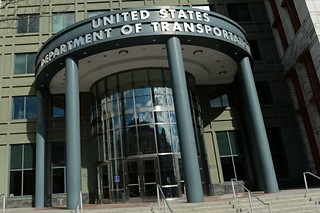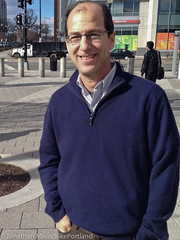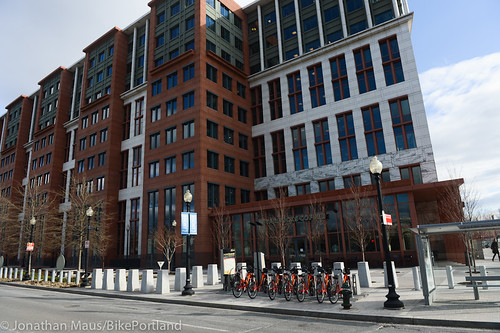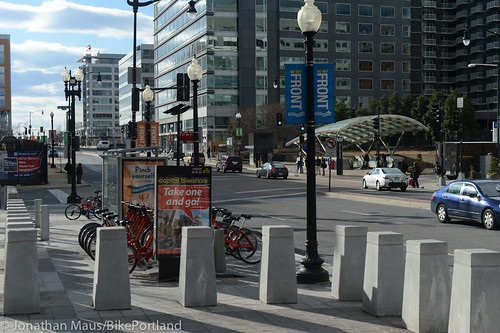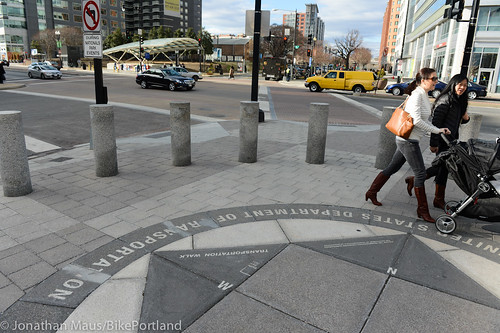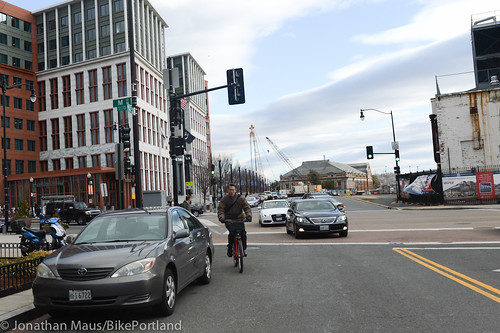Masked by the state and regional agencies that disperse its grant funds and shrouded behind the veil of a federal government bureaucracy with 60,000 employees, the enigmatic and powerful United States Department of Transportation (USDOT) sits at the top of the transportation world. While in DC this past week, I wanted to try and lift that veil with a visit to its home base and by getting to know a few of the people who work there.
My ultimate goal was to sit down for an interview with USDOT Secretary Ray LaHood; but despite being told I was on a short-list, my name never got called. That will happen someday, but on this trip I was more than happy to get a tour of the headquarters building from LaHood’s public affairs staffer Todd Solomon.
I’ve worked with Solomon via email for several years, so it was great to finally put a face to a name. While you’ve likely never heard of him, you’ve almost certainly read his work. Sec. LaHood revealed during a speech at the National Bike Summit that Solomon is the editor of the popular Fast Lane blog which has done an effective job over the years at frothing up bike advocates with bold proclamations like Tuesday’s, “A safe lane for bicycles means more than just painting a stripe in the road.”
Before sharing a bit about my tour and the folks I met; it’s worth noting a few things about the USDOT building itself. Who would have thought that the USDOT, the agency despised by many for its highway-centric legacy and old-school, auto-centric policies, is located smack dab in the middle of a new urbanists’ dream. Built in 2007, the first thing I noticed about the LEED certified building was the Capital Bikeshare station located just steps away from its front door.
Also mere meters from the building is a Metro station and several bus stops. In every direction, blocks are being torn up to build new high-rise, mixed-use residential towers. It sort of feels like a mix between Portland’s South Waterfront and a more working-class Pearl District. It’s not all great though. The main road outside the building, New Jersey Avenue SE, is a classic urban highway where cars, trucks and buses rule and bicycling isn’t something most people would do. And unfortunately even with the bikeshare station, there aren’t good bikeways in any direction.
New Jersey Ave could use a road diet:
This DOT employee grabbed a bike to head home…
But unfortunately doesn’t have great bike infrastructure to get him there…
Even with these quibbles, I can’t help but think the fledgling example of smart urban growth right outside its door is a good influence on the 5,000 or so USDOT employees that work at this location.
Back inside, Todd Solomon took me up an elevator to a sea of cubicles and we poked our heads into one belong to to Lilly Shoup. Shoup is a policy analyst in the Office of the Secretary. Among other things, Shoup works on the Partnership for Livable Communities, a collaboration between the USDOT, Housing and Urban Development, and the Environmental Protection Agency. She’s also part of the policy team that will look to make the USDOT’s roadway design standards more bike friendly. A bike rider herself, she said there’s a strong core of bike commuters at USDOT. They have an internal bike rider email list, they host and participate in events that promote bicycling, and the building has an indoor bike parking facility.
From there, Solomon introduced me to Robert Ritter with the FHWA’s Office of Safety Integration. Ritter is the man tapped with putting together the bike safety summits LaHood announced earlier this week. He said the summits will bring together people from different disciplines and interest groups to find out what works — and what doesn’t — when it comes to bike safety. The locations, dates and other details of the summit are still up in the air, so stay tuned.
I then followed Todd across the building to the FTA wing of the building. As we walked through a large atrium, I looked up and saw this big bike symbol hanging over the entryway.
And here’s Sec. LaHood’s office:
made possible by:
- Planet Bike
- Pro Photo Supply
- Readers like you!
The next person I met was Matthew Lesh, a transportation program specialist in the FTA’s Office of Mobility Innovation. Lesh seemed like one of those creative and brilliant types that’s always thinking a few years ahead of everyone else. He’s tracking everything from pod cars to personal transit vehicles and he’s one of their bikesharing experts. Lesh has also done a lot of policy work on the integration of bicycles and transit. He helped write the program guidelines that allow FTA grants to fund biking facilities near transit stations. I asked Lesh if the FTA would ever accept bikeshare as an officially recognized public transit option. He said it’s too early for that; but it could happen in a few years.
Several other folks Solomon wanted me to meet weren’t immediately available, so he and I chatted for a bit before I rode back downtown. It was great to finally get inside the DOT. Knowing the places and faces behind the acronyms, programs and policies makes it much easier to understand them. And it’s great to have a few more people I can call on to help me track USDOT news.
Thanks Rob, Lilly, and Matt for letting me bug you; and thanks to Todd for showing me around.


